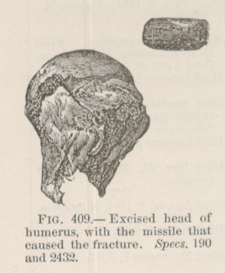Title: Morrison, John
Source text: The Medical and Surgical History of the War of the Rebellion. (1861-65.), Part 2, Volume 2 (Washington, DC: Government Printing Office, 1876), 537-538.
Civil War Washington ID: med.d2e31399
TEI/XML: med.d2e31399.xml
CASE 1509.—Private John Morrison, Co. F, 109th Pennsylvania, aged 35 years, was wounded at Cedar Mountain, August 9, 1862, and was admitted to Armory Square Hospital, Washington, on the 15th. Surgeon D. W. Bliss, U. S. V., made the following special report: "The patient had always enjoyed perfect health up to the time of the injury. When struck he was in the act of firing, the whole arm being raised on a horizontal plane, parallel to the shoulder, and the ball took effect in the surgical neck of the right humerus. He walked one mile, and was then taken in an ambulance to Culpeper, where he received surgical care. The wound was probed and search made for the ball, but to no purpose. Cold-water dressings were applied. On August 15th, the patient was sent by railroad to Washington and admitted to this hospital; he was extremely feeble and restless, with an anxious countenance and anorexia, entire indifference as to situation, pulse 110, the wound emitting copious sanious discharge. Examination showed that the ball had produced a compound fracture of the humerus at the surgical neck, and ploughed a groove along the head, opening the capsule. The ball could not be found. There was considerable depression from effect of wound. Opiates and stimulants were administered, and tepid substituted for cold water. August 19th, resection was performed by Surgeon Bliss, assisted by Surgeons Clymer, Brinton, and Breed. The head of the humerus was excised by the ∨ incision, disarticulated and removed; the shattered end of the shaft below the fracture was taken off, with the chain saw, to the length of an inch and a half, and the spiculæ of bone embedded in the surrounding tissues carefully removed. The ball could not be found, nor its course traced, but it was supposed to be lodged in the axilla or thoracic walls. The incision was closed by interrupted sutures, and a tent introduced at the dependent point. Tepid-water dressings were applied; opiates in small and oft-repeated doses, alternated with brandy and beef tea, were given. September 1st, patient is improving; pulse at 90; healing by granulation has commenced. September 5th, the wound is rapidly granulating; the discharge is profuse but of a healthy character. Same treatment continued. September 7th, the arm is dressed with strips of adhesive plaster applied so as to form an easy and firm support. Patient is permitted to walk about through the ward. September 16th, patient still improving. October 1st, patient is attacked with febrile symptoms; the discharges from the wound are less profuse. October 7th, the fever proved to be of the intermittent type, accompanied by anorexia and night sweating. These symptoms were controlled by powders containing sulphate of quinine, ipecac, opium, and tannic acid, one of which was given every three hours, and by minute doses of oxide of zinc. October 12th, patient complained of a tumefaction on the shoulder, which, on examination, was found to be extremely tender; it was small, hard, circumscribed, and situated an inch and a half below the middle of the spine of the scapula. An incision was made, and a conoidal ragged bullet was extracted; some pus of an unhealthy character escaped from the wound. The incision in the arm is nearly closed. October 25th, both incisions are nearly closed, and the general health of the patient is good." The specimen (FIG. 409), contributed by the operator, consists of "the head of the right humerus excised through the surgical neck. An elongated ball fractured the great tuberosity, crushing in the cancellated structure. A small portion of the anatomical neck is involved. The line of excision is very oblique. The missile is mounted with the specimen." This soldier was discharged from service December 12, 1862, and pensioned. Dr. Bliss saw the man in Philadelphia in May, 1865, and reported that he had a useful arm. Examiner J. Neill reported, April 27, 1868, less favorably regarding the results of this excision. The Philadelphia Examining Board of 1873, Drs. Goodman, Sherwood, and Collins, describe "the arm swinging, dumb, and with little power; forearm weak."
